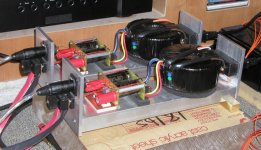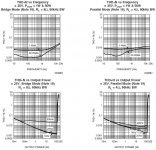On the LM3886 do you use a zobel on the output?
Hi Carlos
I first built it according to your latest recommendations. Later removed the zobel and couldn't hear any difference. The removal of the i/p low-pass brought a very small improvement.
analog_sa said:Hi Carlos
I first built it according to your latest recommendations. Later removed the zobel and couldn't hear any difference.
Maby your speakers are a tricky load...
You could try an R+L zobel in series with the output.
analog_sa said:The removal of the i/p low-pass brought a very small improvement.
What low-pass?😕
jackinnj said:The LM4780 is just a pair of LM3886's in one package.
The internal schematic for the LM3875 is virtually identical to the LM3886 with the exception of the mute function.
Yes, but there are differences in board layout when you implement them.
The LM4780 has a crazy pinout, not very good for a proper PSU bypass.
It has some advantages, though.
But in the end I would rather prefer to use LM3886 chips.
jackinnj said:The LM4780 in parallel mode has the ability to drive lower impedance loads. Into a nominal 8 ohm load, the bridged and paralleled LM4780 configurations are both capable of 120 watts (with a whoppingly large heat sink.)
Yes, the thing is if there's something to loose in sound quality when you parallel chips.
Peter Daniel said:I finally managed to get the bridged setup with one LM4780 per channel. The balanced signal is provided by ML380S preamp.
While it's still in evaluation stage, it sounds pretty good so far.
Compared with a single LM3886 for channel, how do you describe the sound ?( more detail ? )
The detail and focus is good, better than in parallel configuration. The imaging seems to be rock solid, with cleaner background.
I'm still not sure about the "magic" factor, but I need more time to figure that out (the amp needs breaking in too).
I'm still not sure about the "magic" factor, but I need more time to figure that out (the amp needs breaking in too).
Peter Daniel said:The detail and focus is good, better than in parallel configuration. The imaging seems to be rock solid, with cleaner background.
I'm still not sure about the "magic" factor, but I need more time to figure that out (the amp needs breaking in too).
you should find (as I did) that the THD of the bridged amp is about an order of magnitude better than the parallel amp -- but the parallel amp has a much easier time with "tricky" loads.
you should find (as I did) that the THD of the bridged amp is about an order of magnitude better than the parallel amp
Why? And for what power output? Btw i have always been a fan of bridge-amp sonics. They seem to solve some tricky issues of grounding the speaker return.
jackinnj said:you should find (as I did) that the THD of the bridged amp is about an order of magnitude better than the parallel amp -- but the parallel amp has a much easier time with "tricky" loads.
Mmmm....
You can see on page 13 of the LM3780 datasheet these graphs.
I don't see such a difference, having in mind that the THD specs for the parallel amp are for 4 ohm loads.
Also, notice the slight better THD in the high frequencies of the parallel amp.
Attachments
analog_sa said:
Why? And for what power output? Btw i have always been a fan of bridge-amp sonics. They seem to solve some tricky issues of grounding the speaker return.
I wonder why myself. It isn't really "an order of magnitude" -- a little bit of hyperbole:
An externally hosted image should be here but it was not working when we last tested it.
these graphs were done by merely replacing the bridge board with the parallel board -- they fit right onto the heatsink, in the same steel chassis. the wiring to the power supply (using audiophile grade (orange) home depot #14 extension cord.)
Oh well that settles it. National must have done something wrong to measure such low distortion in their parallel amp, because yours doesn't perform nearly as well. 😉these graphs were done by merely replacing the bridge board with the parallel board -- they fit right onto the heatsink, in the same steel chassis.
Seriously though, if you take the care to very carefully match the gain and DC offset of your parallel amps then you can expect great performance. If you don't, then the amps will spend as much or more effort fighting each other as driving the speaker, and you will not get good performance at all. Gain should be matched to 0.1% or better. Even precision 1% resistors are not automatically good enough. They need to be matched by hand.
macboy said:
Oh well that settles it. National must have done something wrong to measure such low distortion in their parallel amp, because yours doesn't perform nearly as well. 😉
Seriously though, if you take the care to very carefully match the gain and DC offset of your parallel amps then you can expect great performance. If you don't, then the amps will spend as much or more effort fighting each other as driving the speaker, and you will not get good performance at all. Gain should be matched to 0.1% or better. Even precision 1% resistors are not automatically good enough. They need to be matched by hand.
National probably has the advantage of using a Faraday shielded room to perform their THD +N measurements.
Also -- they were measuring "net" distortion. The lowest distortion I can get on my SG505 is about 0.0007%, which from a statistical viewpoint is the same as 0.001%.
Note also that National's measurements go to 20kHz. Mine go to 100kHz.
The resistors were all matched with an HP3478 5 1/2 digit DVM on the 4-wire method.
- Status
- Not open for further replies.
- Home
- Amplifiers
- Chip Amps
- diferences between the lm3875 and the lm3886?

